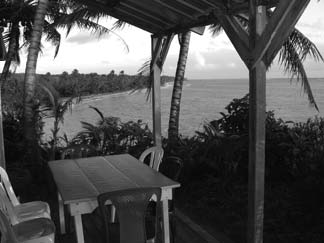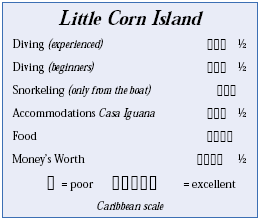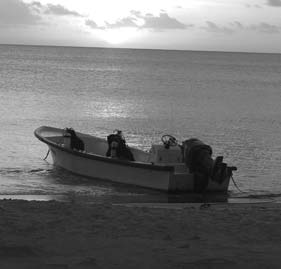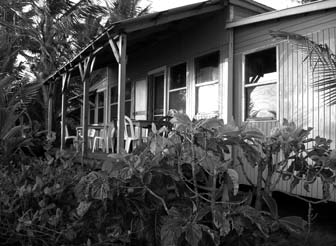Little Corn Island, NicaraguaContents of this Issue: Scuba Pro Recalls X650 Second Stages Is the Nekton Damaging Bloody Bay? When a Liability Waiver Doesn't Count Staying Alive until the Boat Finds You Serious Software Error in Suunto Computers Editorial Office: Ben Davison Publisher and Editor Undercurrent 3020 Bridgeway, Suite 102 Sausalito, CA 94965 a Caribbean road less traveled from the July, 2006 issue of Undercurrent
Dear Reader: I don’t want to offend my many dive buddies who look forward to browsing those Cozumel jewelry shops or eating nachos at the same franchise eateries they could find in Des Moines, but for me that’s no adventure. Sure the diving is good, but I prefer reefs less traveled. So, in February my partner and I headed for the Caribbean coast of Nicaragua, where the only jewelry sold was strung seashells and no one had heard of nachos. My only question was whether the diving was any good.
After spending a pleasant evening in a hotel near the Managua airport, I was shuttled by the hotel’s van for a 7:00 a.m. flight to Big Corn Island, 50 miles off the coast. Along with 25 islanders and a handful of travelers, I boarded a huge panga and a half hour later I stepped onto the beach in front of Dive Little Corn, which is owned by the Casa Iguana Hotel, my home for a week. Running along the “front side” of Little Corn Island is a sidewalk fronted by a few small businesses. The only wheeled vehicles on Little Corn, population 900, are bicycles and wheelbarrows. “Streets” are sidewalks or dirt paths. Once dominated by British colonizers, the traditional population of African ancestry speaks English, though some mainland “Nicas” have moved to the islands. While I occasionally switched between English and my bad Spanish, I could have just as well stuck with English.
At 2:00 p.m. my partner and I were on the dive shop deck for a briefing so thorough I thought the site, White Holes, must be their featured attraction. Turns out that the DMs give this kind of briefing for every dive. I waded to the boat and ten minutes later backrolled off for my first look at Little Corn diving. White Holes (sand holes in the coral) is a shallow formation capped with an elkhorn forest (elkhorn is so under threat that the U.S. government may label it an endangered species). Two funny-faced clown wrasses were display-fighting in a mouth-to-mouth posture. Halfway through the dive, I stopped counting the nurse sharks. In the coming days I would see dozens, none more than 7 ft. Besides the typical reef residents, most sites were loaded with juvenile slippery dicks, and some had beautiful black-on-yellow juvenile puddingwives. I saw eagle rays on most dives, but few large food fish, such as snappers and grouper. Perhaps more disconcerting was the colorful but heavy algae growth. The cause certainly couldn’t be effluent from tiny Little Corn. Could it be the lack of big parrotfish? When I mentioned it to the dive staff, I just got puzzled looks.
Elsewhere, the coral looked healthier. I liked My Place and Yellowtail, both low-profile patch reef networks with a sandy bottom at 50-60 ft. At My Place I watched five big midnight parrotfish (almost the only type of big parrots I saw) munching the coral. Pompanos flashed high in the water column. A beautiful little goldentail moray peeked out. At 15 ft, I was surrounded by a bloom of spot-winged comb jellies. Yellowtail was similar, but with more schools and cleaning stations. I counted six barracuda being deloused, most by multiple fish, including fairy basslets. I emerged from a short swim-through to a wall of French, Caesar and sailor’s choice grunts. Midnight parrots were joined by queens and the tiny pink-on-turquoise blue lip parrot. A swarm of bluehead wrasses had broken the defense of a male sergeant major and were devouring his purple egg clutch. After the dive, I handed up my weight belt and BC and climbed a side ladder. Although a one-person dive shop has opened next door at Delfines Hotel, Dive Little Corn is Nicaragua’s first dive operator, so many reefs bear monikers of former staffers. They do three dives a day, using a panga with tank racks and room for eight divers. The open boat has no amenities, but sites are close and intervals are spent at the beach. They carry a DAN O2 kit. They split us eight divers (there are fewer in the off-seasons) into two groups, each under the eyes of one of their North American divemasters, Tim or Carron, both competent and agreeable. By the time you get there, others will have replaced them, I suspect. Turnover is high. Between dives, they switched aluminum 80s on the boat, and Tim switched my buddy’s high pressure hose without breaking a sweat. Rental gear, yes; Nitrox, no. They limited dives to 55 minutes. (The 82F water kept them pleasant.) The DMs allowed divers the option to do their own thing but managed to annoy my little group when we wanted to do a third dive to a 60-ft site after a second dive to 50 ft. Oddly, they firmly vetoed this “reverse profile.” After diving, I carried my gear up to the shop, rinsed it, and stored it in their secure area. After two morning dives, my friends and I would walk down the front side for lunch. I liked the cheese empanadas (turnovers) at the next-door Colombian restaurant, and the Cuban restaurant was a good choice for lunch, dinner or drinks. None of these joints had signs, nor are they needed. One day a norther blew through and wiped out diving, so folks fell back on the Caribbean three Rs: rum, relaxation, and romance. I took a 15-minute walk to the lighthouse for good views of the island, then wandered on trails to the north end, where an eccentric German runs a little camp-resort. A 30-minute beach walk gets you to Peace and Love Farm and a good Italian dinner; Casa Iguana will radio them to make a reservation. Despite the isolation, the island is rather cosmopolitan. The young guy who runs the Colombian restaurant is from the nearby Colombian island of San Andres, but his parents are from Venezuela and Nicaragua. He was happy to chat about Caribbean life, as were Captain Jorge and other folks we met. I did one night dive at Buoy (misnamed: there is none). Starting early, we saw the grunts leaving the reef in the twilight. After dark, I found a 3-ft turtle snoozing in the coral. I cut a wide circle with my light to avoid waking it, but the big guy stirred and swam over me. By then the red swarm -- the cardinals and squirrel fish -- were rising. A basket star spread wide over a gorgonian, and I found three large lobsters, a surprise since the economy is based on lobster fishing. On a day dive, hundreds of small bar jacks circled the site. About 100 mojarra hung motionless over the bare sand, as if in a trance. A ray gently pushed off the sand and let me shadow it. This reef has a well-defined halo of bare sand, with turtle grass beyond. The 20 ft bare patch marks the limit of where the algae eaters will venture from the safety of the reef. Sites outside the reef are accessible on calmer days. At Shark Hole, I entered a long and convoluted tunnel. Halfway through it, hundreds of glassy sweepers parted to let me pass. Forty minutes into the dive, a 6-ft reef shark crossed in front and another cruised past the divers behind me, followed by an eagle ray. At Tarpon Channel, the stars are apparently hammerheads (the divemasters claim it’s a 50/50 chance to see them) though at ten minutes and 70 ft into the dive, my buddy’s pressure gauge blew, so we left the movie before the plot developed. Captain Jorge spotted us within seconds, so we didn’t suffer a surface swim. The DM reported two hammerheads. Tarpon Channel, Sueños, Shark Hole and other windward sites, most of which have nice swim-throughs and overhangs, often have murky 20-50 ft visibility, which gives the shark’s sensory system an advantage over prey. While the Delfines Hotel is clean and air-conditioned, most readers of Undercurrent will prefer Casa Iguana and its 13 casitas. The deluxe casitas sit atop a low cliff overlooking the reef on the windward side. These are simple but comfy, with potable well water from the tap and a private porch, a great place for reading. There’s no a/c (but the sea breeze kept it perfect) and no hot shower water unless the sun gets the rooftop tank warm (which made it easy to obey the “please conserve water” sign). Most electricity comes from wind power, though they run the generator (and open the satellite-dish Internet café) each morning. The American owners, Cathy Sherman and Grant Peeples, have spent ten years shaping it into a genuine eco-resort. What other resort’s website boasts “Ten reasons we may not want you to come here,” beginning with “Your favorite travel destination has been Nassau, Bahamas.” Casa Iguana catches most of their meals (if you go on their fishing boat, your catch is dinner), buys local lobster and conch, and grows vegetables and fruit in an extensive garden. For a remote resort, the full dinners are excellent. Most nights I had fresh barracuda or lobster, prepared in various ways, and always fresh vegetables and good desserts. And the inevitable Toña or Victoria beer. The breakfasts are plain but plentiful with a half-dozen good choices, all with fresh fruit on the side. Excellent coffee is always available.
The guests were an interesting mix of divers and travelers with whom I spent evenings in the comfy lodge, imbibing, playing cards, and talking diving. Some were off sailboats; others were there to fish. Most were North Americans, a few Europeans. A friendly Irishman was on a six-month world tour, and an American was kicking back after serving as assistant captain on an Aggressor. After several days of patch reefs on a flat bottom, I missed the sensation of flying over the deep blue off a wall. The deepest site here is Phil’s Find, where the reef top is 60 ft and the sand floor is 95 ft. As compensation, the beautiful cover girl on Paul Humann’s Reef Fish, the rare golden hamlet, with its black and electric-blue face, is common -– I spotted four on one dive. The studded sea star, described in Humann’s Reef Creatures as a rare and undescribed species, is also common. And there aren’t many Caribbean spots where you can reliably find unchummed sharks in an unspoiled environment. Perhaps their top dive is Blowing Rock. Only six divers can make the trip, and because I was slow to sign up, I was relegated to more reef dives. However, a friend who joined us for part of the week told me: “After a smooth 50-minute ride, we arrived at a pinnacle of rocks. On the first dive, we headed to the bottom, which slopes from 80 ft to more than 100. The first thing I noticed was the sheer number of large fish. Schools of big bar jacks, snappers (including cuberas), as well some big midnight parrots and mixed schools of tangs. Diving on the coral-and-sponge-encrusted boulders, some of them house-sized, reminded me of Los Islotes off La Paz in Baja. “On our first dive, three reef sharks suddenly appeared, darting erratically, maybe hunting or jostling with each other. I got as close as I wanted under the circumstances. We circled the islet on each dive, taking a shallower profile on the second. Between dives we spent an hour interval on the boat, where the rock pinnacle provided little relief from the swells. The trip back, against the wind and seas, was bumpier than the morning trip. This is a dive you don’t usually experience in the Caribbean and worth the ride and the $90 (instead of the usual $60) for the two dives.” When divers sit around the bar, inevitably the talk gets to dive locations. When I mention an off-brand place like Cayos Cochinos, Honduras, or María la Gorda, Cuba, everyone wants to know more. But I suspect they still book their next trip to the Caymans. Most divers want that extra bit of comfort and predictability. I’ve never regretted heading in less-traveled (and less expensive) directions, and this was a fine trip. So, if you’re an off-the-beaten-track sort of diver, happy with a good array of fish, some nice patch reefs, and a bit of an adventure, pencil this in. But do more than pencil in Blowing Rock, because that’s one boat you’ll want to be on. – M.A.
|

I want to get all the stories! Tell me how I can become an Undercurrent Online Member and get online access to all the articles of Undercurrent as well as thousands of first hand reports on dive operations world-wide
| Home | Online Members Area | My Account |
Login
|
Join
|
| Travel Index |
Dive Resort & Liveaboard Reviews
|
Featured Reports
|
Recent
Issues
|
Back Issues
|
|
Dive Gear
Index
|
Health/Safety Index
|
Environment & Misc.
Index
|
Seasonal Planner
|
Blogs
|
Free Articles
|
Book Picks
|
News
|
|
Special Offers
|
RSS
|
FAQ
|
About Us
|
Contact Us
|
Links
|
3020 Bridgeway, Ste 102, Sausalito, Ca 94965
All rights reserved.


 Casa Iguana measures up quite well.
The staff carried our gear by wheelbarrow
on a ten-minute trip through the woods
and hotel vegetable garden to our casita,
#1, private yet close to the restaurant. I
had a comfortable bed, low wattage but adequate
24-hr lighting (115V power available),
a desk, a clean inside bath, and a private
outside shower. From the very private
porch, with chairs and hammock, I viewed the
wide Caribbean expanse and long empty beach.
A friendly iguana viewed me from a rafter
above. The setting, cottage, and grounds
looked as good as the website advertised. I
felt safe and welcomed. The island’s three
police officers enjoy free breakfast daily at Casa Iguana, but I doubt they find
much to do here but walk around town visiting.
Casa Iguana measures up quite well.
The staff carried our gear by wheelbarrow
on a ten-minute trip through the woods
and hotel vegetable garden to our casita,
#1, private yet close to the restaurant. I
had a comfortable bed, low wattage but adequate
24-hr lighting (115V power available),
a desk, a clean inside bath, and a private
outside shower. From the very private
porch, with chairs and hammock, I viewed the
wide Caribbean expanse and long empty beach.
A friendly iguana viewed me from a rafter
above. The setting, cottage, and grounds
looked as good as the website advertised. I
felt safe and welcomed. The island’s three
police officers enjoy free breakfast daily at Casa Iguana, but I doubt they find
much to do here but walk around town visiting. 

 DIVER’S COMPASS: Dive Little Corn charges $30 per dive if you do
15 and one is free. Deluxe casitas at Casa Iguana are $55/night,
double. Prices include the 15% tax. Dinner is $9 (or order lobster
for $15), breakfast $4.50, beer/pop/juice $1.50, mixed drinks
$2.50. Their website (
DIVER’S COMPASS: Dive Little Corn charges $30 per dive if you do
15 and one is free. Deluxe casitas at Casa Iguana are $55/night,
double. Prices include the 15% tax. Dinner is $9 (or order lobster
for $15), breakfast $4.50, beer/pop/juice $1.50, mixed drinks
$2.50. Their website (